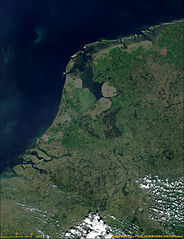 |
| The Netherlands/Wikimedia Commons |
Let's look at the damage sofar: 90 deaths in the U.S., of which 41 in New York City; over 6 million households have been or are still without power; hundreds of homes along the shore damaged or destroyed; the nation's leading subway and railway system which is still not fully in use; and the list goes on and on. The Financial Times reports that "Sandy will rank among the eight most costly storms ever to have struck the US, with losses to the insurance industry of at least $7bn..... The more pessimistic say initial forecasts have a tendency to underestimate the final tally, as was the case with hurricanes Katrina and Irene. One consultancy, PwC, says the total costs to the economy may well reach $45bn."
Clearly, the first priority is to take care of the victims and repair damage. But what if similar hurricanes would hit again: is there a way to reduce or avoid all together this kind of damage? Matthew Yglesias wrote an article in Slate, New Amsterdam May Have To Look Back to the Netherlands To Control Future Flooding where he says:
"The best place to look for guidance is probably the city's former colonial overlords in the Netherlands who've been trying for a while now to market their flood control expertise through their Holland Trade website.... The idea of essentially damming up New York Harbor sounds extreme, but that's equivalent to what the Dutch did with the Zuiderzee Works and especially the Delta Works projects undertaken after the 1953 flood. Some of the Dutch works are permanent dikes, but others are open sluices that merely shut when storms are coming to block surges. The idea is to in effect shorten your coastline which makes it easier to defend with high walls."
 |
| Oosterscheldekering-DeltaWorks/JvandeSande |
For those not very familiar with the Netherlands, here follows a short, fun and inspiring video about this little country on the North Sea. The video below is about Holland's sea barriers:
Although, the Netherlands due to its geography still runs substantial risks from rising sea levels and climate change - see for example, an OECD report mentioned in my previous post The Day After Tomorrow - it has been truly successful and innovative in achieving coastal security for its people. This model could, indeed, provide a solution for New York City and its harbor in avoiding future disasters. It's time for New York leadership to discuss the options with Dutch engineers. Let's stay tuned.
No comments:
Post a Comment